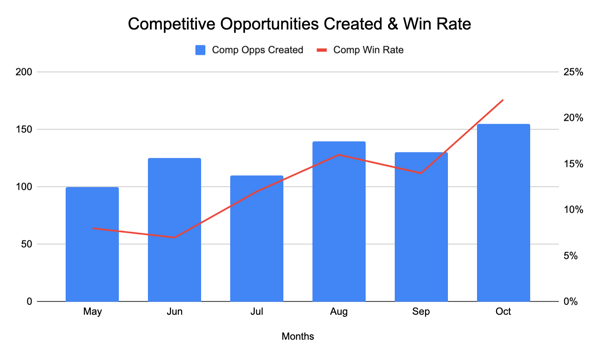One of the most significant frustrations product marketers face is the disconnect between their work and quantifiable business outputs. Nearly every organization with a dedicated product marketing team has much larger sales, product development, and campaign marketing teams. Those teams benefit from having an unambiguous connection between their inputs and critical, quantifiable outputs, especially revenue.
We’ve written previously about the challenge of tying product marketing to quantifiable Key Performance Indicators (KPIs). That challenge is growing. Now, other marketing functions are moving away from “vanity metrics” like the sheer volume of leads or Marketing Qualified Leads (MQLs), and towards metrics that are closer to revenue like marketing-led sales opportunities and even marketing-attributed revenue.
Fortunately, there are several ways product marketers can take their revenue attribution skills to the next level.
Competitive Win Rate
The ability to directly influence the success of a revenue-driving function like sales is an underutilized power wielded by product marketers. Competitive win rate, more specifically, is the simplest KPI for product marketers to latch onto. While overall win rate is impacted by a myriad of factors, competitive win rate is more linear and is more directly influenced by the competitive enablement provided by product marketing.

Battlecards have quickly become the most popular form of competitive enablement aimed at improving win rate. Before embarking on the journey of creating battlecards or any other type of competitive enablement, make sure you have the proper mechanisms in place to measure their impact. If your organization isn’t already measuring competitive win rate, now is a good time to befriend your sales/marketing operations team.
Ready to get started? Download the Product Marketing Measurement Template
A simple field at the opportunity level in your CRM that allows sales reps to identify which competitors are present in a sales cycle is the first step. Then, add a “loss reason” field as well to ensure you can zero in on deals lost explicitly to competitors and not other reasons like lack of urgency. Once you’ve established a competitive win rate benchmark, you’ll be ready to roll out your battlecards and watch the win rate (hopefully) increase.
Don’t stop there.
Remember, we’re taking it a step further and tying your work directly to revenue. From here, make sure to tap your middle school algebra skills and calculate the impact of that win rate increase on overall revenue. If your organization generates $10m of pipeline every quarter and 40% of your deals are competitive, increasing your win rate from 30% to 40% across the board would constitute a $400,000 increase in revenue every quarter. If that doesn’t earn product marketing a spot at your annual President’s Club trip, nothing will.

Adoption, Retention, and Upsell
Product usage, customer happiness (as measured by NPS or similar surveys), and other metrics that contribute to overall adoption are not uncommonly measured by product management, product marketing, or both. While these are great quantifiable metrics for product marketing to latch onto, they’re still several steps removed from revenue. There are two ways product marketing can measure and influence customer-specific metrics that they can further tie directly to revenue.
Adoption to Revenue
Product management leverages adoption metrics with the goal of guiding product development. On the other side of that coin, product marketing should view those metrics from the lens of driving revenue. Do customers with stronger adoption metrics renew or upsell at higher rates? Most likely. Figure out the correlation between key adoption metrics (usage of specific product features, NPS, number of active users, or any other metrics you have access to) and rates of retention or increased upsell/cross-sell. Then, work with campaign marketers and account managers to lead campaigns focused around improving those metrics to grow install base revenue.
Customer Upsell/Retention Enablement
The notion of measuring and improving competitive win rate shouldn’t begin and end with the new business side of your organization. Most account management/customer success teams have a strong focus on retention, upsell, or both, depending on the maturity of the business. If you’ve already created competitive enablement for your new business sales team, rework them slightly to tailor them to the competitive use cases of your account management team. Then, make sure your renewal and upsell opportunities in your CRM have fields similar to those for new business opportunities so you can continuously measure the impact your competitive enablement has on upsell and retention metrics.

Campaign Performance
Content marketing and demand generation enjoy a much more direct line between their work and revenue-based results. Product marketers should leverage their superior knowledge of their product and industry to support these efforts whenever possible.
Product Marketing-Driven Content
Supporting content production is one of the most simple, direct ways product marketers can influence revenue. Case studies, industry-focused thought leadership, and any content that focuses on your product should be created partially or entirely by product marketing. Don’t let measurement of your efforts here end with usage. Track how your content progresses through the go-to-market funnel from usage to sales opportunity to marketing-attributed revenue. Work with demand generation to ensure it’s promoted to the right audiences to maximize the impact.
Product Launches and Campaigns
Product launches represent one of the best opportunities for product marketing to directly impact revenue. Before any product launch, work closely with demand generation to set goals around the campaign driving the launch. Measure sales demo requests, downloads of content associated with the launch, and anything else quantifiable. As always, make sure to follow those metrics to the bottom of the funnel, where they convert to revenue.
Outside of product launches, other campaigns run by demand generation teams also benefit from product marketing’s expertise. When a campaign focuses on a complex product feature, industry trend, or is targeted at a new, less-understood market, input from product marketing can be invaluable. Work closely with demand generation to A/B test messaging/copy in display ads, campaign emails, and website/landing pages. This provides the dual benefit of being a quantifiable, revenue-based activity and allows for product marketing to receive quantifiable feedback on their messaging.
The nebulous goals and outcomes of product marketing teams can be sharpened by taking a revenue-minded approach to every input. Ultimately, product marketing is one of the most cross-functional teams in every organization. Understand and proactively measure the revenue-based impact of your work with every team, and the difficulty in measuring the value of your work will dissipate.

Seeing is believing! Check out Crayon for yourself.
Take a Product TourRelated Blog Posts
Popular Posts
-
 The 8 Free Market Research Tools and Resources You Need to Know
The 8 Free Market Research Tools and Resources You Need to Know
-
 6 Competitive Advantage Examples From the Real World
6 Competitive Advantage Examples From the Real World
-
 How to Create a Competitive Matrix (Step-by-Step Guide With Examples + Free Templates)
How to Create a Competitive Matrix (Step-by-Step Guide With Examples + Free Templates)
-
 24 Questions to Consider for Your Next SWOT Analysis
24 Questions to Consider for Your Next SWOT Analysis
-
 How to Measure Product Launch Success: 12 KPIs You Should Be Tracking
How to Measure Product Launch Success: 12 KPIs You Should Be Tracking



